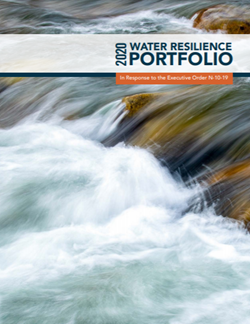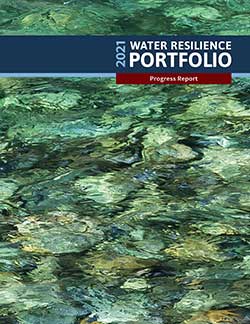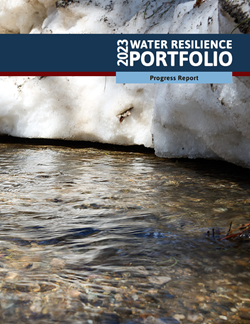California’s roadmap to building water resilience through a diverse set of actions that will prepare our water systems to support our growing state in a warmer, more variable climate.
On July 28, 2020, Governor Gavin Newsom released a final version of the Water Resilience Portfolio, the Administration’s blueprint for equipping California to cope with more extreme droughts and floods and rising temperatures, while addressing long-standing challenges that include declining fish populations, over-reliance on groundwater and lack of safe drinking water in many communities. In January 2022, the Administration released a progress report documenting its efforts to implement the portfolio over the previous 18 months. A second progress report, capturing implementation actions from January 2022 through September 2023, was released in October 2023
No single solution can fully address the state’s water challenges. The portfolio embraces a broad, diversified approach. Goals and actions are organized into four categories:
1. Maintain and diversify water supplies: State government will continue to help regions reduce reliance on any one water source and diversify supplies to enable flexibility as conditions change. Diversification will look different in each region based on available water resources, but it will strengthen water security and reduce pressure on river systems across the state.
2. Protect and enhance natural ecosystems: State leadership is essential to restore the environmental health of many of our river systems in order to sustain fish and wildlife. This entails effective standard setting, continued investments, and more adaptive, holistic environmental management.
3. Build connections: The state aims to improve physical infrastructure to store, move, and share water more flexibly and integrate water management through shared use of science, data, and technology.
4. Be prepared: Each region must prepare for new threats, including flashier floods, deeper droughts, and hotter temperatures. State guidance will enable preparation, protective actions, and adaptation.
Though the actions in the portfolio are the responsibility of state agencies to implement, those actions emphasize the need for local, regional, tribal, federal, and private entities to coordinate across watersheds to build a resilient “water system of systems” across California. As detailed in the October 2023 progress report, state agencies are making significant progress carrying out each of the 142 separate actions in the Water Resilience Portfolio, and coordination is underway across the state to address water challenges.
The California Natural Resources Agency, California Environmental Protection Agency, and Department of Food and Agriculture developed the Water Resilience Portfolio to fulfill Governor Gavin Newsom’s April 29 executive order calling for a portfolio of actions to ensure the state’s long-term water resilience and ecosystem health.
To develop the portfolio, state agencies conducted an inventory and assessment of key aspects of California water and solicited broad input from tribes, agencies, individuals, groups, and leaders across the state. An interagency working group considered the assessment and input from more than 20 public listening sessions across the state and more than 100 substantive comment letters.
The agencies released a draft version of the portfolio for public feedback in January 2020. Input from more than 200 separate individuals and organizations helped shape revisions, including the addition of 14 new actions. The revisions give greater emphasis to tribal interests and leadership, upper watershed health, and cross-border water issues.
State agencies intend to track and share progress on portfolio implementation with an annual report.Why Do We Need a Resilience Portfolio?
California faces a range of water challenges, some long-standing, others related to the increasingly warm climate. These challenges include unsafe and undependable drinking water supplies, major flood risks, severely depleted groundwater supplies, and the threat of extinction to native fish species. No single fix can ameliorate these stubborn challenges, prepare us for climate change, and protect our natural environment. In his April 2019 Executive Order calling for the Water Resilience Portfolio, Governor Newsom noted that providing clean, dependable water supplies to communities, agriculture, and industry while restoring and maintaining the health of watersheds will require collaborative strategies between government, sovereign tribes, local communities, water agencies, irrigation districts, environmental conservationists, academia, business and labor leaders, and other stakeholders.
Why is Climate Change Part of the Discussion?
Climate change projections indicate a future characterized by more intense droughts and floods and winter storms that bring less snow and more rain. We cannot exactly predict how the interplay of higher average temperatures, increased variability in precipitation, depletion of soil moisture, and accelerated evapotranspiration will affect the hydrological cycle. To cope with a likely future of “wetter wets” and “drier dries,” California water managers must start planning and investing now in strategies that include more efficient use of water, recycling of water, additional storage, additional conveyance to facilitate recharge of aquifers, improved forecasting tools, better data about river flows and water consumption, and restoration of upper watersheds.
What are Some Major Components of the Portfolio?
The portfolio includes 142 separate actions to be taken by state agencies to support local efforts to maintain and diversify water supplies, protect and enhance natural systems, build connections (whether human, physical, or digital), and prepare for future risks. Key actions include continued implementation of historic laws such as the Safe and Affordable Drinking Water Act of 2019, the Sustainable Groundwater Management Act of 2014, and the 2018 package of water-use efficiency laws known as the “make conservation a way of life” laws. The portfolio prioritizes construction of new places to store water, both above and below ground, through the Proposition 1 Water Storage Investment Program, and it supports timely promulgation of new regulations that will allow water districts to directly distribute recycled water. Other portfolio actions emphasize the need to reconnect aquatic habitat – such as through the removal of four obsolete dams on the Klamath River – and to encourage farmers to adopt practices that build soil health and harbor biodiversity.
Who Leads Implementation of the Portfolio?
Implementation is led by Secretary for Natural Resources Wade Crowfoot, Secretary for Environmental Protection Jared Blumenfeld, and Secretary of the Department of Food and Agriculture Karen Ross. Nancy Vogel, Deputy Secretary for Water at the Natural Resources Agency, manages interagency coordination as staff across state government carry out the actions in the Portfolio.






